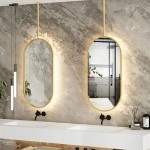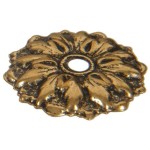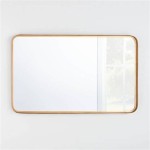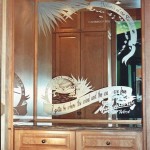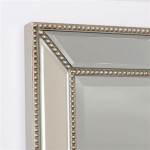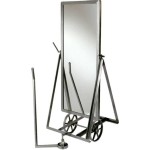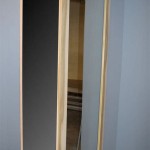How to Hang Heavy Mirrors Without Nails: A Damage-Free Guide
Hanging a heavy mirror can be a daunting task, especially when aiming to preserve the wall's integrity by avoiding nails. Fortunately, several effective methods allow for secure mounting without causing damage. This guide outlines various techniques suitable for different wall types and mirror weights, ensuring both aesthetic appeal and safety.
Choosing the Right Hanging Method
Selecting the appropriate hanging mechanism is crucial for ensuring the mirror's stability and preventing accidents. Factors to consider include the mirror's weight, the wall's material, and the desired aesthetic. Heavier mirrors will require more robust solutions than lighter ones.
Heavy-Duty Adhesive Strips
Adhesive strips designed for heavy objects offer a convenient and damage-free solution for smooth surfaces like painted walls, tiles, and glass. These strips utilize advanced adhesive technology to provide a strong bond, capable of supporting substantial weight. However, they are not suitable for textured walls or wallpaper.
Mirror Mounting Clips
Mirror mounting clips offer a secure and adjustable hanging solution. These clips are typically attached to the wall using screws or adhesive, and the mirror then slides into the clips. This method allows for minor adjustments to the mirror's position and provides a stable hold for heavier mirrors. It is essential to choose clips specifically designed for the mirror's weight and thickness.
French Cleats
French cleats offer a robust and versatile hanging solution for exceptionally heavy mirrors. This system consists of two interlocking pieces of wood: one attached to the wall and the other to the back of the mirror. The interlocking design provides a secure and stable connection, capable of supporting significant weight. French cleats are ideal for situations where maximum stability is required.
Utilizing Wire and D-Ring Hangers
For mirrors with pre-installed D-ring hangers, hanging wire can be used in conjunction with adhesive hooks or specialized non-damaging wall anchors. This method offers flexibility in positioning the mirror and allows for level adjustments. Ensure the wire and hooks are rated for the mirror's weight.
Adhesive Hooks for Lighter Mirrors
While not suitable for very heavy mirrors, strong adhesive hooks can be a viable option for lighter ones, especially on smooth surfaces. Multiple hooks can be used to distribute the weight evenly, enhancing stability. Always check the weight limit of the adhesive hooks before use.
Preparing the Wall Surface
Proper wall preparation is crucial for successful adhesion, regardless of the chosen method. Clean the wall surface thoroughly with a mild detergent and allow it to dry completely. For adhesive strips or hooks, ensure the surface is smooth and free from dust, grease, or debris. This step ensures optimal bonding strength and prevents the mirror from falling.
Measuring and Marking for Accurate Placement
Before hanging the mirror, measure and mark the desired location on the wall. Use a level to ensure the markings are straight and even. Precise measurements are essential for achieving a visually appealing and balanced display.
Testing the Installation
After installing the hanging mechanism and mounting the mirror, gently test its stability by applying light pressure. If the mirror feels secure, allow the adhesive or anchors to set fully according to the manufacturer’s instructions before applying significant weight or leaning against the mirror. This precautionary step ensures the mirror is properly secured and minimizes the risk of accidents.
Specialized Hanging Systems
For extremely heavy or oversized mirrors, consider using specialized hanging systems designed for heavy artwork or displays. These systems typically involve more robust hardware and offer enhanced stability and security. Consulting a professional installer may be advisable for very large or heavy mirrors.
Choosing the Appropriate Anchors
If using screws or anchors, select the appropriate type for the wall material. Drywall anchors are suitable for drywall, while masonry anchors are required for brick or concrete walls. Choosing the correct anchor ensures a secure and stable installation.
Weight Distribution for Large Mirrors
For large and heavy mirrors, distributing the weight evenly is crucial. Use multiple hanging points or a combination of methods to ensure the weight is supported adequately and prevent excessive stress on any single point.
Safety Considerations
Always prioritize safety when hanging heavy mirrors. Wear appropriate safety gear, such as gloves and eye protection, when handling tools and materials. If unsure about any aspect of the installation process, seek assistance from a qualified professional.

How To Hang A Heavy Mirror Without Nails 4 Alternative Ways Homelyville

How To Hang A Heavy Mirror Without Nails Worst Room

How To Hang A Mirror On Wall Without Nails

3 Simple Ways To Hang A Mirror On Wall Without Nails Wikihow

How To Hang Heavy Mirrors Frames Without Nails 3m

How To Hang A Heavy Mirror At Home

How To Hang A Mirror On Wall Without Nails Guide For All Diyers

How To Hang Heavy Mirrors Frames Without Nails 3m

3 Simple Ways To Hang A Mirror On Wall Without Nails Wikihow

How To Hang A Heavy Mirror C R F T

